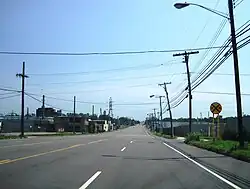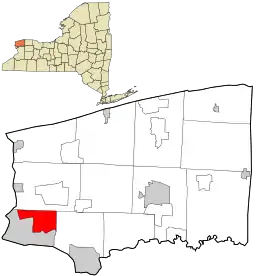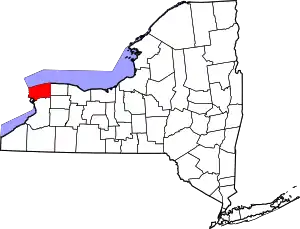Niagara, New York
Niagara is a town in Niagara County, New York, United States. At the time of the 2010 census, the town had a total population of 8,378. The town is named after the famous waterfall Niagara Falls.
Niagara
| |
|---|---|
| Town of Niagara | |
 Hyde Park Boulevard (NY 61) southbound on the border of the town of Niagara and city of Niagara Falls (town on left) | |
| Motto(s): A Great Place to Live, Work & Shop | |
 Location in Niagara County and the state of New York. | |
 Niagara Location within the state of New York | |
| Coordinates: 43°6′58″N 78°59′22″W | |
| Country | |
| State | |
| County | Niagara |
| Government | |
| • Type | Town Council |
| • Town Supervisor | Lee Wallace (D) |
| • Town Council | Members' List |
| Area | |
| • Total | 9.48 sq mi (24.56 km2) |
| • Land | 9.48 sq mi (24.56 km2) |
| • Water | 0.00 sq mi (0.00 km2) |
| Elevation | 623 ft (190 m) |
| Population (2010) | |
| • Total | 8,378 |
| • Estimate (2016)[2] | 8,081 |
| • Density | 852.07/sq mi (329.00/km2) |
| Time zone | UTC-5 (Eastern (EST)) |
| • Summer (DST) | UTC-4 (EDT) |
| ZIP Code | 14305 |
| Area code | 716 |
| FIPS code | 36-51033 |
| GNIS feature ID | 0979275 |
The Town of Niagara is in the southwestern portion of Niagara County, borders the City of Niagara Falls (which is next to the famed Niagara Falls). Also located partially within the town is Niagara Falls International Airport, which serves the Niagara County area.
It is served by the LaSalle Post Office on Niagara Falls Boulevard (U.S. Route 62) in adjacent Niagara Falls, New York. Residents use a mailing address of "Niagara Falls, NY" because of this. Neither "Niagara, NY," nor "Town of Niagara, NY" are acceptable postal addresses, according to the United States Postal Service.
History
The Town of Niagara was founded in 1812 (originally as the "Town of Schlosser" after the local fortification Fort Schlosser and after Captain Joseph Schlosser, a German officer in the British Army) from the Town of Cambria.[3] In 1836 eastern parts of the town were organized as the Town of Wheatfield, New York.
In 1892, the City of Niagara Falls was formed from the western end of town, taking about half of its land. In 1897, the Village of LaSalle was incorporated in what was then the southeast corner of the town.[4] LaSalle was in turn annexed by the City of Niagara Falls in 1927, reducing the size of the Town of Niagara to 9.4 square miles (24 km2).[4] Its borders have remained the same since.
Geography
According to the United States Census Bureau, the town has a total area of 9.4 square miles (24 km2), all land.
Adjacent cities and towns
- Town of Lewiston - north[3]
- Town of Wheatfield - east[3]
- City of Niagara Falls - west, south[3]
Major highways in the Town of Niagara
 Interstate 190 (Niagara Expressway), This interstate through the western part of town from the Niagara Falls city line to the Lewiston town line. In the town, there are exits at Porter Rd. (NY 182) and Witmer Rd. (NY 31).
Interstate 190 (Niagara Expressway), This interstate through the western part of town from the Niagara Falls city line to the Lewiston town line. In the town, there are exits at Porter Rd. (NY 182) and Witmer Rd. (NY 31). U.S. Route 62 (Niagara Falls Blvd.), North-South highway that has a short distance in the town from the Wheatfield town line to the Niagara Falls city line.
U.S. Route 62 (Niagara Falls Blvd.), North-South highway that has a short distance in the town from the Wheatfield town line to the Niagara Falls city line. New York State Route 31 (Witmer Rd., Saunders Settlement Rd.), East-West Highway across the northwestern part of town from the Lewiston town line to the Niagara Falls city line.
New York State Route 31 (Witmer Rd., Saunders Settlement Rd.), East-West Highway across the northwestern part of town from the Lewiston town line to the Niagara Falls city line. New York State Route 61 (Hyde Park Blvd.), North-South Roadway mostly in the City of Niagara Falls, but has a short distance in the southwest corner of town where the route has its northern end at Lewiston Rd. (NY 104).
New York State Route 61 (Hyde Park Blvd.), North-South Roadway mostly in the City of Niagara Falls, but has a short distance in the southwest corner of town where the route has its northern end at Lewiston Rd. (NY 104). New York State Route 182 (Porter Rd.), East-West roadway through the town from the Niagara Falls city line near its interchange with I-190 to its eastern terminus at Niagara Falls Blvd. (US 62).
New York State Route 182 (Porter Rd.), East-West roadway through the town from the Niagara Falls city line near its interchange with I-190 to its eastern terminus at Niagara Falls Blvd. (US 62). New York State Route 265 (Military Rd.), North-South roadway through the town from the Niagara Falls city line to the Lewiston town line.
New York State Route 265 (Military Rd.), North-South roadway through the town from the Niagara Falls city line to the Lewiston town line.
Notable person
- James Madison, Medal of Honor recipient
Demographics
| Census | Pop. | Note | %± |
|---|---|---|---|
| 1820 | 484 | — | |
| 1830 | 1,401 | 189.5% | |
| 1840 | 1,277 | −8.9% | |
| 1850 | 1,951 | 52.8% | |
| 1860 | 6,603 | 238.4% | |
| 1870 | 6,832 | 3.5% | |
| 1880 | 7,432 | 8.8% | |
| 1890 | 10,979 | 47.7% | |
| 1900 | 1,066 | −90.3% | |
| 1910 | 1,648 | 54.6% | |
| 1920 | 4,173 | 153.2% | |
| 1930 | 865 | −79.3% | |
| 1940 | 2,618 | 202.7% | |
| 1950 | 4,729 | 80.6% | |
| 1960 | 7,503 | 58.7% | |
| 1970 | 8,368 | 11.5% | |
| 1980 | 9,648 | 15.3% | |
| 1990 | 9,880 | 2.4% | |
| 2000 | 8,978 | −9.1% | |
| 2010 | 8,378 | −6.7% | |
| 2016 (est.) | 8,081 | [2] | −3.5% |
| U.S. Decennial Census[5] | |||
As of the census[6] of 2000, there were 8,978 people, 3,611 households, and 2,480 families residing in the town. The population density was 955.8 inhabitants per square mile (369.0/km2). There were 3,879 housing units at an average density of 412.9 per square mile (159.4/km2). The racial makeup of the town was 92.99% White, 3.02% African American, 1.47% Native American, 0.56% Asian, 0.02% Pacific Islander, 0.22% from other races, and 1.72% from two or more races. Hispanic or Latino of any race were 1.17% of the population.
There were 3,611 households, out of which 29.6% had children under the age of 18 living with them, 51.1% were married couples living together, 13.0% had a female householder with no husband present, and 31.3% were non-families. 26.1% of all households were made up of individuals, and 9.9% had someone living alone who was 65 years of age or older. The average household size was 2.49 and the average family size was 2.99.
In the town, the population was spread out, with 23.4% under the age of 18, 8.9% from 18 to 24, 28.0% from 25 to 44, 25.1% from 45 to 64, and 14.6% who were 65 years of age or older. The median age was 39 years. For every 100 females, there were 95.1 males. For every 100 females age 18 and over, there were 92.3 males.
The median income for a household in the town was $37,327, and the median income for a family was $43,689. Males had a median income of $35,657 versus $25,358 for females. The per capita income for the town was $17,500. About 7.1% of families and 9.3% of the population were below the poverty line, including 14.6% of those under age 18 and 3.9% of those age 65 or over.
Communities
- Pletchers Corners
- Cayuga Village
- Belden Center
- colonial village
Government
The Town is governed by the Town Supervisor form of government lead by an elected Supervisor and four Town Council members.
The Town of Niagara Police Department is a separate agency from that of the Niagara Falls Police Department serviving the City of Niagara Falls, New York.[7]
Economy
Major employers in Niagara are retail stores along major routes in town, including:
- Fashion Outlets of Niagara Falls
- Niagara Stone Corporation Redland Quarry - limestone quarry
- Niagara Falls International Airport
- New York Air National Guard
- New York Air Force Reserves
- Air Force Reserve Center
- Wegmans (Hills) Plaza
- Mil-Pine Plaza
- Witmer Industrial Estate
Services
Niagara Active Hose Company provides fire protection to Niagara from their fire hall on Lockport Road.
Town of Niagara Police Dept Serves and Protects the town community by enforcing local and state law. The department is located at 7105 Lockport Road
References
- "2016 U.S. Gazetteer Files". United States Census Bureau. Retrieved July 5, 2017.
- "Population and Housing Unit Estimates". Retrieved June 9, 2017.
- "Town of Niagara | Town of Niagara". www.townofniagara.com. Retrieved August 16, 2023.
- "120th anniversary lecture of incorporation of Village of LaSalle".
- "Census of Population and Housing". Census.gov. Retrieved June 4, 2015.
- "U.S. Census website". United States Census Bureau. Retrieved January 31, 2008.
- "Police Department | Town of Niagara".
